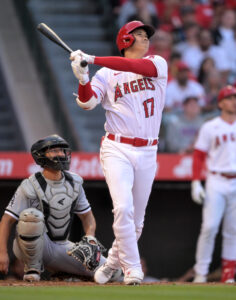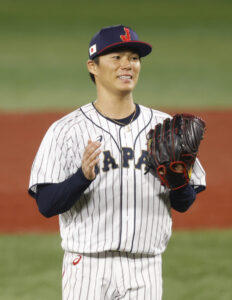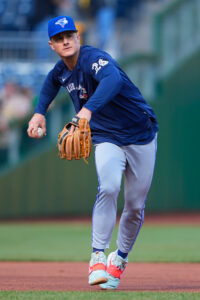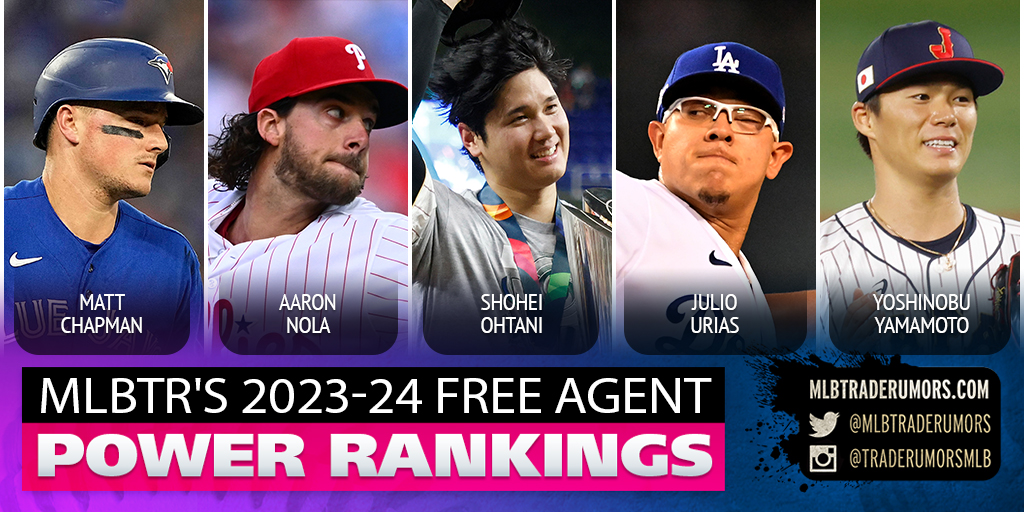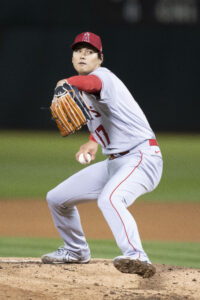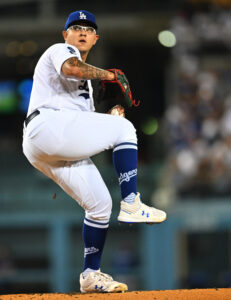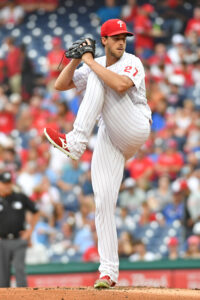We’re now about three quarters of the way through the regular season, and the free-agent landscape has changed considerably since our last power rankings back in June. With the trade market passed, we now know who will and won’t be eligible to receive a qualifying offer at season’s end. (Traded players cannot receive a QO.) Max Scherzer needn’t be listed at the back of the list or among the honorable mentions now that he’s agreed to pick up next year’s player option as part of the condition of his trade to Texas. Injuries, performance trends — both good and bad — and many other factors all contribute to shifts in market expectation.
As a reminder, our Power Rankings are based primarily on perceived earning power. This is an exercise intended to provide a snapshot of where the top end of the free agent class is currently sitting. One player being ranked higher than another does not necessarily indicate we feel he’s the better player. Age, health, qualifying offer status, market scarcity and myriad other factors all impact what a player can expect to earn in free agency.
Our Power Rankings are compiled collaboratively. MLBTR owner Tim Dierkes and writers Anthony Franco and Darragh McDonald all weighed in for this update. Players with opt-out clauses and player options are included, even if they’ve previously given indications they may forgo the opportunity to return to the market.
*=Player option/opt-out opportunity
**=Currently playing in Japan’s Nippon Professional Baseball
1. Shohei Ohtani, DH/SP, Angels
Eligible for qualifying offer
The baseball world is still reeling from this week’s news that Ohtani has been diagnosed with a torn ulnar collateral ligament for the second time in his career. He won’t pitch again this season, and surgery — be it Tommy John or an internal brace — is firmly on the table. For now, he’ll continue to serve as the Angels’ DH as he and the team receive outside opinions on his damaged ligament.
There’s no way around the fact that Ohtani’s injury represents a massive blow to his earning power — but perhaps not to the extent that many fans would think. Ohtani is still the best player on the planet, doing things that we simply haven’t seen in our lifetimes — arguably ever before. The 29-year-old’s .304/.409/.659 batting line puts him 80% ahead of the league-average hitter, by measure of wRC+, and prior to his injury, he’d run up 132 innings of 3.14 ERA ball.
Ohtani ranks seventh in the Majors in batting average, second in on-base percentage, first in slugging percentage (by more than 60 points), tenth in ERA and third in strikeout percentage (as a pitcher). We’ve grown almost accustomed to this level of excellence, but the manner in which he permeates both the offensive and pitching leaderboards in Major League Baseball is nothing short of prodigious.
Certainly, it’s an open question as to whether Ohtani will pitch at all next year. By the time he’s reached free agency, we’ll likely know the answer to that question. Depending on whether he needs surgery — and, if so, which surgery he requires — it’s possible he’ll miss the beginning of the 2024 season. Bryce Harper had offseason Tommy John surgery this past year and returned to the Phillies on May 2. Ohtani himself had his first Tommy John surgery in October 2018 and was back on the field as a designated hitter on May 7 the following year.
Even if Ohtani is ruled out from pitching next year, any team signing him would be paying for one of the game’s best hitters — and for a potential return to the mound in 2025. It’s fair to wonder just how long Ohtani can continue pitching and hitting simultaneously and do so at elite levels, but he’s spent the past three years proving those who doubted his preternatural talents wrong. The ultra-competitive Ohtani will surely try to do so again; there’s little reason to think he’d move on from pitching due to a second surgery. What shape that eventually takes — limiting him to five innings most starts, affording him extra rest throughout the season, moving him to the bullpen, etc. — will likely depend on the team with which he eventually signs.
Regardless of Ohtani’s future on the mound, he’ll probably still set the record for largest free agent contract ever. That may sound outlandish to some at first glance, but consider the fact that Ohtani will reach the market two years younger than Aaron Judge was when he scored a $360MM guarantee. Judge landed that record sum as a 31-year-old who ostensibly only had three competitive bidders: the incumbent Yankees, his hometown Giants, and the late-bidding Padres. Ohtani will draw interest from a larger number of teams. And, as marketable as Judge is, Ohtani is even more so. The additional revenues he’d generate from his global fan base can’t be overlooked.
Moreover, Ohtani only seems to be getting better at the plate. After striking out at 28.1% clip through his first four seasons, he dropped that number to 24.2% last year. The lowered strikeout rate also came with a dip in walk rate (down to 10.8%), but this year he’s maintained that improved strikeout rate while bumping his walk rate back to 14.2%. Ohtani is also just two home runs shy of his career-high and looks like a lock to reach 50 home runs. His .360 ISO (slugging minus batting average) is a career-high. Ohtani’s 94.9 mph average exit velocity trails only Judge, and his 118.3 mph maximum exit velo this season trails only Matt Olson. No player has hit a ball further than Ohtani’s MLB-best 493 feet, per Statcast.
Ohtani’s second UCL tear could shorten his 2024 season and might necessitate extra care for his arm when he returns to the mound — be that late in the 2024 season or early in the 2025 campaign. But he’s probably going to pitch again — he’ll certainly try to — and even if he doesn’t, he’s hitting the market as one of baseball’s premier offensive players in advance of his age-29 season. Plus, if Ohtani were to ever give up pitching, he wouldn’t be “just” a designated hitter, as many detractors have suggested. Ohtani is no stranger to the outfield, having played there during his NPB days. Statcast still credits him with 65th percentile sprint speed, and there’s no questioning his raw athleticism and arm strength. There’s little reason to think he couldn’t at least be a serviceable corner outfielder.
Age and elite offensive performance on their own still ought to push Ohtani past Judge this winter. The only question will be how far beyond Judge he can ultimately club. Securing the first $400MM free agent contract in history feels attainable even with the questions surrounding his arm. Time will tell if $500MM+ remains on the table.
2. Cody Bellinger, CF/1B, Cubs
Eligible for qualifying offer
Bellinger jumps from unranked on our last list to the No. 2 spot in a matter of just two months. At the time of our June list, he’d just been reinstated from the injured list and was mired in what turned out to be a fleeting slump. We listed Bellinger as an honorable mention and considered him for a spot near the bottom of the list, but felt he needed to improve his stock a bit. He’s done that — and then some.
Not many one-year, make-good deals have gone as well as Bellinger’s remarkable bounceback season. Non-tendered by the Dodgers after shoulder surgery left him a shell of his former Rookie of the Year and MVP self from 2021-22, Bellinger now looks to be back in a big way. The 2019 Most Valuable Player is batting .320/.368/.552 with 20 home runs, 21 doubles, a triple and 17 steals in 20 tries. The most alarming element of his downturn in 2021-22 was a strikeout rate that ballooned to 27.1%, but Bellinger is now punching out at a career-low 15.5% rate.
Bellinger’s rebound isn’t without red flags, as I noted last week when profiling his season at greater length. He missed more than a month with a knee injury, and in more under-the-radar fashion, the quality of his contact is just nowhere near as good as it was at his peak. Bellinger is averaging 87.2 mph off the bat — four miles per hour slower than during his MVP season. A hefty 45.6% of his batted balls left the bat at 95 mph+ in 2019; he’s at 30.8% in 2023. He’ll also receive and reject a qualifying offer, though for free agents of this caliber, that’s rarely a significant deterrent.
The Cubs have played Bellinger both at first base and in center field this season, and he’ll draw interest from teams with visions of playing him at first base and across all three outfield spots. He drew plus ratings from Defensive Runs Saved and Outs Above Average in his return to first base, and he’s been credited with +4 OAA in center field this year. Teams will see Bellinger as a versatile and above-average defender at multiple spots on the field.
The other factors to consider with Bellinger are age and market scarcity. He won’t turn 29 until July 13 of next season, meaning next year will technically be considered his age-28 season. (July 1 is the typical cutoff for such designations.) He’s considerably younger than the standard free agent, and he happens to hit the market in a year where there’s not only a lack of quality outfielders/first baseman — but a lack of quality bats overall.
Bellinger is at least two years younger than each of Kris Bryant ($182MM), Brandon Nimmo ($162MM) and George Springer ($150MM) were when they hit free agency. He’s having a better offensive platform year than any of that group at the plate. Bellinger and Scott Boras will likely be seeking $200MM+ in free agency this time around, and there’s a real chance he’ll get it.
3. Yoshinobu Yamamoto, SP, Orix Buffaloes**
Ineligible for qualifying offer
At the time of our June list, Yamamoto was sitting on a 1.98 ERA in 68 1/3 frames, positioning him to potentially finish the season with his fourth sub-2.00 ERA in the past five years. Since that time, he’s allowed five total runs in 51 2/3 frames. His 0.87 ERA in that stretch has dropped his season mark to 1.50 over the life of 120 innings. He’s averaging seven innings per start in NPB this year.
If age was worth mentioning with regard to Bellinger, it’s worth focusing on in near-singular fashion with Yamamoto, who turned 25 just last week. Yamamoto is one of the most accomplished pitchers in NPB — widely regarded as the second-best league in the world — despite the fact that he’s around the same age as some of the yet-to-debut names that populate top prospect lists here in North America. He went straight from the NPB draft into the Buffaloes’ rotation, and while his 5.32 ERA as a rookie wasn’t exactly captivating, Yamamoto followed with a 2.10 ERA in 2019 and has been established as an ace-caliber pitcher ever since.
Most MLB free agents hit the market between 29 and 31 years of age. There are occasional 28-year-old free agents, and even more rarely we’ll see a 27-year-old or even 26-year-old, if said player reached the big leagues as some kind of youthful phenom. Yamamoto will be signing a contract beginning with his age-25 season — a virtually unprecedented age for a top-of-the-rotation arm to reach the market. A six-year deal for him would run through only his age-30 season — the same age at which many MLB free agents are just getting to market. It’s always hard to predict how the market might react to star players coming over from NPB or the Korea Baseball Organization, but Yamamoto’s blend of age and performance is basically unprecedented. It’s easy to envision him receiving offers of eight years — possibly even more — based on his youth. Presumably, Yamamoto’s camp could look to work some opt-out opportunities into any deal as well.
Yamamoto isn’t a true free agent; he’ll need to be posted by the Buffaloes, though it’s widely expected they’ll do just that. Any team that signs Yamamoto would owe his former club a release fee equal to 20% of the contract’s first $25MM, 17.5% of the next $25MM and 15% of any money thereafter (including options, incentives, awards bonuses, etc.). On a $200MM deal, for instance, the signing team would owe an additional $31.875MM release fee.
Predicting contracts for foreign stars is always something of a dice roll — far more than standard MLB free agents, where precedent is more abundant. Yamamoto lacks any true comparables in terms of market context seasons, but the demand for him should be fierce.
4. Julio Urias, SP, Dodgers
Eligible for qualifying offer
To call the 2023 season an “uneven” one for Urias would be a bit of an understatement. The southpaw got out to a strong start through his first four turns on the mound, stumbled badly over his next five appearances, and hit the injured list with a hamstring strain. Urias was set to return after just a few weeks but suffered a setback and wound up missing nearly two months with the injury. Upon his return, he was rocked for five runs in three innings, sending his ERA ballooning to 4.94. He was dominant for his next two turns (one run in 12 innings with a 15-to-2 K/BB ratio) … then blown up for eight runs in Baltimore.
The pendulum swung back in the other direction following that outing, and Urias is still on the upswing. In his past five starts, he’s posted a 2.03 ERA. Overall, Urias has a 4.15 ERA on the season and a 3.88 ERA since returning from the injured list. Much of the damage done against him this season has been confined to five brutal outings.
Urias isn’t a power arm. He’s averaging 92.9 mph on his fastball this season — a career-low, but barely down from the 93.1 mph he averaged in 2022 when he posted a 2.16 ERA in 175 frames. He’s never been a huge strikeout pitcher, and this year’s 24.1% rate is in line with his previous levels: solidly above average, but far from elite. However, he’s always boasted exceptional command, and his 4.9% walk rate in 2023 is the best of his career. His walk rate ranks 10th among the 93 pitchers who’ve thrown at least 100 innings this season and is only 0.1% behind the three pitchers ahead of him on the list (Joe Ryan, Miles Mikolas, Zack Wheeler).
Urias is a tough free agent to peg. From 2018-22, he logged a brilliant 2.61 ERA in 499 1/3 innings, but due largely to a .252 BABIP and 79.8% strand rate, fielding-independent metrics were far less bullish (3.42 FIP, 3.80 SIERA). And, because of early-career shoulder surgery, Urias’ workload was limited aggressively until the 2021 season. He’s only made 30 starts in a season twice (2021 and 2022), and he won’t reach that level in 2023. Urias was also arrested in May 2019 after video reportedly showed him shoving a female companion to the ground. Major League Baseball subsequently suspended him for 20 games under the joint domestic violence, sexual assault and child abuse policy. Though it was several years ago, that still figures to weigh into the evaluation process for many teams.
The biggest factor Urias will have on his side in free agency will be age. Because he debuted as a 19-year-old, he’s reaching the open market at just 27 years of age. He won’t turn 28 until next August. Because of that youth, Urias could be in line for a lengthier contract than the standard pitcher, which is why he and Yamamoto stand as the top non-Ohtani pitchers on this ranking. Even an eight-year deal would only run through the left-hander’s age-34 season.
5. Matt Chapman, 3B, Blue Jays
Eligible for qualifying offer
Chapman’s first month of the 2023 season was something to behold. When I wrote about his brilliant start to the season in early May, the two-time Platinum Glove winner was raking at a .338/.425/.579 clip. He’d “only” homered five times in six weeks but was already up to 17 doubles. As noted at the time, he’d struck out at a considerably lower rate than past seasons in April but had begun to swing and miss more in May. “If Chapman can avoid allowing his recent uptick in whiffs to snowball, then a return to peak levels or even the establishment of a new peak output is firmly in play,” I wrote at the time.
Unfortunately — the whiffs indeed snowballed. Chapman fanned at just a 22.8% clip through the end of April, but he’s gone down on strikes in 29.5% of his plate appearances since that time. Since that look at Chapman’s sensational start to the season … he’s batted .212/.302/.373 (88 wRC+).
On the whole, Chapman’s season has still been productive. His .250/.339/.435 slash is 15% better than league average, by measure of wRC+. He’s ripped 15 home runs, 35 doubles and a triple in 507 plate appearances and drawn walks at a very strong 11% clip. More encouraging is the fact that when Chapman makes contact, he’s absolutely scorching the ball. This year’s 93.7 mph average exit velocity is in the 97th percentile of MLB hitters. Only Aaron Judge and Matt Olson have put a higher percentage of their batted balls in play at 95 mph or more than Chapman’s outrageous 57.2%.
That batted-ball profile will undoubtedly intrigue many teams. Chapman will be viewed as something of an “upside” play with the bat, which is a strange way to characterize someone who we’re ranking fifth in earning power among this year’s free agents. That said, Chapman’s power, ability to draw walks and elite defense give him a high floor, and the elite level of his contact and his prior track record suggest something closer to an MVP-level ceiling. Defensive Runs Saved credits Chapman at +11 this year, while Outs Above Average is at +4. He’s never ranked as a negative in either category.
Both Trevor Story (six years, $140MM) and Dansby Swanson (seven years, $177MM) secured deals well north of $100MM due in large part to their strong gloves and offensive ceilings. Kris Bryant landed $182MM coming off a comparable (albeit better) offensive year — despite lacking anything close to Chapman’s defensive value. Story and Swanson got those contracts despite having turned down qualifying offers. Chapman will turn down a QO as well, and even with the way his bat has sputtered since the first month of the season, he’ll still have a case to end up somewhere in this general range.
6. Jordan Montgomery, SP, Rangers
Ineligible for qualifying offer
Few pitchers have elevated their stock more than Montgomery in recent seasons. The 30-year-old southpaw — 31 in December — missed most of the 2018-19 seasons due to Tommy John surgery and posted a 5.11 ERA in 10 starts during the shortened 2020 campaign. Montgomery’s strikeout, walk and grounder rates all remained sharp during that ugly season, though, creating some optimism that he could yet bounce back.
He’s done more than bounce back in the three years since. Montgomery reestablished himself as a viable big league starter in 2021, but he’s steadily elevated himself to No. 2-3 starter status — and he only seems to be getting better. Dating back to 2021, Montgomery has piled up 482 2/3 innings and recorded an impressive 3.49 ERA with a 22.8% strikeout rate, 6.3% walk rate, 45.5% grounder rate and just 1.01 HR/9. He spent two weeks on the Covid-related injured list in 2021 but has otherwise avoided the IL entirely since returning from Tommy John surgery.
The 2023 season, in particular, is shaping up to be the best of Montgomery’s career. He’s posted a minuscule 1.73 ERA in four starts since being traded from the Cardinals to the Rangers, dropping his season-long mark to a career-best 3.12. Montgomery’s 93.6 mph average fastball is the best of his career. He’s striking hitters out at only a league-average level but also limiting walks at a considerably better-than-average rate and inducing grounders at an above-average clip.
Montgomery may not stand out in any one way, but he boasts average or better skills across the board and has shaken off that early ligament replacement surgery to establish himself as a durable mid-rotation starter. His results, peripherals and general durability are all superior to those of Jameson Taillon (four years, $68MM) and Taijuan Walker (four years, $72MM) last offseason. Because he was traded midseason, he can’t receive a qualifying offer.
Many will be tempted to lump Montgomery into the Walker/Taillon bucket, but he’s been the best pitcher of that trio and is heading into free agency on a high note. Taillon and Walker feel like more of a floor than anything else for Montgomery, who ought to be able to command a fifth guaranteed year. With a strong and healthy finish to the season, he could secure a nine-figure deal.
7. Aaron Nola, SP, Phillies
Eligible for qualifying offer
Nola, who turned 30 this summer, has been a standard of durability for the past six years. He hasn’t gone on the injured list with a non-virus issue since 2017. No pitcher has started more games or logged more innings since the start of 2018. For the bulk of that time, he has paired that league-best durability with at least high-end #2 starter results.
The right-hander has six sub-4.00 ERA seasons under his belt, including a 3.25 mark over 205 innings a season ago. From a run prevention perspective, he’s struggling through a relative down year in 2023. Nola has allowed 4.49 earned runs per nine through 26 appearances. The longball has been the big culprit, as he has already surrendered a personal-high 29 homers in 160 1/3 innings (1.63 HR/9).
Nola has lost a few punchouts as well, although he’s still missing bats at an above-average rate. His 25.2% strikeout percentage is his lowest rate in six years but above the 22% league mark for starters. While his whiffs were way down early in the season, he has a characteristic 28.2% strikeout rate going back to the start of June. The homers have become even more of an issue as the summer has drawn on, but Nola’s strikeout and walk profile of the past three months has resembled that of his entire career.
A pitcher’s home run rate can vary season-to-season. Nola’s ground-ball percentages have nosedived over the past couple years, though. This looks as if it’ll be his second campaigns in the last three years with a middling ERA, as he posted a 4.63 mark in 2021. Nola’s ERA has been above estimators like FIP and SIERA for three years running. Will teams attribute that primarily to poor luck and the lackluster defenses the Phils have turn out behind him, or to something in Nola’s repertoire that makes him more hittable than his strikeout and walk profile would suggest?
The Phils and Nola had some extension conversations during the spring but didn’t appear to get close to a deal. He’ll receive and reject a qualifying offer. A five or six year deal topping nine figures should still be attainable, but it’d be easier to project Nola approaching or beating the $162MM which Carlos Rodon received last winter were it not for the home run concerns.
8. Lucas Giolito, SP, Angels
Ineligible for qualifying offer
Aside from the unique cases of Ohtani and Yamamoto, Giolito was the top pitcher in our late-June rankings. The right-hander was sitting on a 3.41 ERA at the time but has allowed a 5.92 mark in nine starts since that point. That’s primarily a reflection of two absolute clunkers — an eight-run drubbing by the Mets on July 18 and nine runs at the hands of the Braves during his first start as an Angel on August 2.
Largely because of those outings, Giolito’s season ERA has jumped to 4.32. Home runs have been an issue, particularly since he landed in Anaheim, but the rest of his profile is generally solid. Giolito hasn’t maintained the form he flashed from 2019-20, when he struck out a third of opponents in consecutive seasons with a sub-3.50 ERA. He now looks the part of a solid #3 starter, fanning a quarter of opponents against an 8.2% walk rate while averaging just under six innings per start.
His velocity is right in line with last year’s mark. His 12.2% swinging strike rate — while down from its 2019-21 peak — is a bit better than average. While Giolito’s small sample ERA with the Angels sits at 6.67, his repertoire, whiffs and control are all in line with his early-season work in Chicago. It’s likely teams will consider his tough first month in Orange County a blip and more or less continue to view him as an above-average, durable starting pitcher.
Giolito turned 29 last month. He’s a year younger than Nola, Snell and Montgomery but markedly older than Urias and Yamamoto. Since he was traded midseason, clubs wouldn’t have to forfeit a draft choice to sign him (as they would for Snell, Nola and Urias). While the past month has been a disaster for the Angels, Giolito’s free agent stock shouldn’t be much different than it was six weeks ago. Given his age, a six-year deal still seems plausible.
9. Blake Snell, SP, Padres
Eligible for qualifying offer
Snell, the 2018 American League Cy Young winner, has become the veritable embodiment of the “mercurial” and “volatile” adjectives that are often used to describe pitchers. The 30-year-old looked lost early in the season, logging a 5.40 ERA and 13.4% walk rate in his first nine starts. Since then, he’s been perhaps the most dominant pitcher in baseball. Over his past 17 starts, Snell has pitched 97 innings with a 1.48 ERA.
One might be tempted to assume that Snell has corrected the command troubles that dragged him down early on — but that’s not the case. Snell has continued walking more than 13% of his opponents during this stretch, with the primary difference being a massive spike in strikeouts (from 23.8% up to 34.8%) and grounders (37% to 49.7%). Snell has scaled back the usage of his heater in that time, deferring to more changeups and curveballs. The formula has worked beautifully. Snell ranks seventh in the Majors in Baseball-Reference’s version of WAR (3.7) and trails only Arizona’s Zac Gallen with 4.8 RA9-WAR.
Ace-level results from Snell aren’t exactly anything new. Again, he’s a former Cy Young winner. However, Snell has struggled to stay healthy, and his penchant for deep counts and walking batters has frequently led to early exits from games. Snell has averaged under 5 1/3 innings per start in his big league career. That’s not exactly a reflection of the Rays’ affinity for quick hooks on their starting pitchers either; Snell’s 5.17 innings per start since his trade to the Padres is nearly identical to his 5.15 innings per start in Tampa Bay. Even during this year’s dominant effort, he’s averaging just over 5 1/3 innings per outing.
In terms of his per-inning performance and his overall raw stuff, Snell is one of the most appealing pitchers in baseball. But he’s also lacked both consistency and efficiency throughout his career, and he’s been on the injured list due to an adductor strain (twice), a fractured toe, loose bodies in his elbow and gastrointeritis since winning that 2018 Cy Young Award. This year’s 142 innings are already the second-highest total of his career. Snell will also have to contend with a qualifying offer, which he’ll surely reject in search of a longer-term deal.
Snell undoubtedly has his flaws, but over the past calendar year he’s made 33 starts and posted a 2.51 ERA with a 31.8% strikeout rate, 12.4% walk rate, 42.8% grounder rate and just 0.84 homers per nine innings. He’s pitched 183 innings in that time — just shy of 5 2/3 frames per outing. There’s plenty of reason for caution, but Snell at his best is a legitimate Game 1 starter in a postseason series. Volatility notwithstanding, he could land a nine-figure deal of five or more years in length.
10. Josh Hader, RP, Padres
Eligible for qualifying offer
While some of the names on this list have struggled since the June edition of our Power Rankings, Hader has been the opposite. He’s tossed 16 shutout innings since that day, allowing just six hits and punching out 44.6% of his opponents. The 29-year-old now boasts a career-low 0.81 ERA in 44 2/3 innings on the season. He’s carrying a 39.9% strikeout rate, and while his 13.5% walk rate remains high, that’s easier to get away with when two out of every five hitters that come to the plate fall to a strikeout.
There was some concern surrounding Hader as he slumped in the weeks preceding and immediately following last year’s trade to the Padres. He righted the ship following a six-run meltdown in late August, however. Since shaking off that disastrous outing, Hader has pitched 61 1/3 innings of 0.74 ERA ball with a 39.7% strikeout rate and an 11.3% walk rate. He’s still primarily a fly-ball pitcher, but Hader’s 36.3% ground-ball rate is a pretty big jump from the 27.4% mark he posted from 2018-22. He’s using the sinker he implemented in 2022 more than ever this year, and while his 2.6% homer-to-flyball rate is bound to regress, this year’s pristine 0.20 HR/9 is also at least partially influenced by that uptick in grounders.
Hader will receive and reject a qualifying offer. That’s a risk for most relievers, but it’s a slam dunk for Hader, who could become the highest-paid relief pitcher ever within the next few months. He’ll be a year older in free agency than Edwin Diaz was when he set the reliever record on a five-year, $102MM contract (which includes multiple opt-outs). That slight age gap will matter, but Hader has the longer and steadier track record of the two and could benefit from his handedness. Barring a catastrophic collapse or a disastrously timed injury, Hader will take aim at making Diaz’s record and have a good chance at making it short-lived.
Honorable Mentions (listed alphabetically): Harrison Bader (OF), Jeimer Candelario (3B), Sonny Gray (SP), Teoscar Hernandez (OF/DH), Shota Imanaga (SP)**, Michael Lorenzen (SP), Yuki Matsui (RP)**, Eduardo Rodriguez (SP)*, Jorge Soler (DH/OF)*, Marcus Stroman (SP)*
